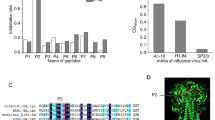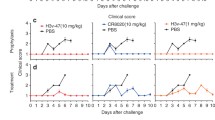Summary
A/seal/Massachusetts/1/80 (H7N7) influenza virus caused maximal hemolysis at pH 5.9. Monoclonal antibodies to each of the four nonoverlapping antigenic areas on the hemagglutinin molecule of the virus inhibited the hemolysis whereas those belonging to two of the groups did not inhibit hemagglutination of the virus. Hemolysis also occurred when the virus was incubated at pH 5.9 prior to addition of erythrocytes. Such hemolysis caused by acid-treated virus was inhibited with the antibodies as well. At pH 5.9, hemagglutination of neither intact virus nor hemagglutinin rosettes was inhibited with any of the monoclonal antibodies, indicating conformational change in the hemagglutinin molecule, at this pH. On the other hand, hemagglutination-inhibition was observed when the antigens were incubated with the monoclonal antibodies at pH 7.0 and then the pH was later shifted to 5.9, suggesting that antibody-binding interferes with the conformational change in the hemagglutinin molecule at pH 5.9. The present findings indicate that antibodies to the hemagglutinin of influenza virus can inhibit virus-induced hemolysis by blocking conformational change in the hemagglutinin molecule and blocking later step of fusion than the conformational change, in addition to blocking attachment of virus to the receptor of erythrocytes.
Similar content being viewed by others
References
Homma, M., Ohuchi, M.: Trypsin action on the growth of Sendai virus in tissue culture cells III. Structural difference of Sendai virus grown in eggs and tissue culture cells. J. Virol.12, 1457–1465 (1973).
Huang, R. T. C., Rott, R., Kienk, H.-D.: Influenza viruses cause hemolysis and fusion of cells. Virology110, 243–247 (1981).
Kida, H., Brown, L. E., Webster, R. G.: Biological activity of monoclonal antibodies to operationally defined antigenic regions on the hemagglutinin molecule of A/seal/Massachusetts/1/80 (H7N7) influenza virus. Virology122, 38–47 (1982).
Klenk, H.-D., Nagai, Y., Rott, R., Nicolau, C.: The structure and function of paramyxovirus glycoproteins. Med. Microbiol. Immunol.164, 35–47 (1977).
Klenk, H.-D., Rott, R., Orlich, M., Blödorn, J.: Activation of influenza A viruses by trypsin treatment. Virology68, 426–439 (1975).
Lazarowitz, S. G., Choppin, P. W.: Enhancement of the infectivity of influenza A and B viruses by proteolytic cleavage of the hemagglutinin polypeptide. Virology68, 440–454 (1975).
Lenard, J., Miller, D. K.: pH-Dependent hemolysis by influenza, Semliki Forest virus, and Sendai virus. Virology110, 479–482 (1981).
Maeda, T., Ohnishi, S.: Activation of influenza virus by acidic media causes hemolysis and fusion of erythrocytes. FEBS Letters122, 283–287 (1980).
Matlin, K. S., Reggio, H., Helenius, A., Simons, K.: Infectious entry pathway of influenza virus in a canine kidney cell line. J. Cell. Biol.91, 601–613 (1981).
Possee, R. D., Schild, G. C., Dimmock, N. J.: Studies on the mechanism of neutralization of influenza virus by antibody: evidence that neutralizing antibody (anti-hemagglutinin) inactivates influenza virusin vivo by inhibiting virion transcriptase activity. J. gen. Virol.58, 373–386 (1982).
Scheid, A., Choppin, P. W.: Identification of biological activities of paramyxovirus glycoproteins. Activation of cell fusion, hemolysis, and infectivity by proteolytic cleavage of an inactive precursor protein of Sendai virus. Virology57, 475–490 (1974).
Skehel, J., Bayley, P. M., Brown, E. B., Martin, S. R., Waterfield, M. D., White, J. M., Wilson, I. A., Wiley, D. C.: Changes in the conformation of influenza virus hemagglutinin at the pH optimum of virus-mediated membrane fusion. Proc. Natl. Acad. Sci. U.S.A.79, 968–972 (1982).
Webster, R. G., Laver, W. G.: Preparation and properties of antibody directed specifically against the neuraminidase of an influenza virus. J. Immunol.99, 49–55 (1967).
Webster, R. G., Hinshaw, V. S., Bean, W. J., van Wyke, K. L., Geraci, J. R., St. Aubin, D. J., Pertrusson, G.: Characterization of an influenza A virus from seals. Virology113, 712–724 (1981).
Webster, R. G., Isachenko, V. A., Carter, M.: A new avian influenza virus from feral birds in U.S.S.R.: recombination in nature? Bull. Wld. Hlth. Org.51, 324–332 (1974).
Author information
Authors and Affiliations
Additional information
With 3 Figures
Rights and permissions
About this article
Cite this article
Kida, H., Webster, R.G. & Yanagawa, R. Inhibition of virus-induced hemolysis with monoclonal antibodies to different antigenic areas on the hemagglutinin molecule of A/seal/Massachusetts/1/80 (H7N7) influenza virus. Archives of Virology 76, 91–99 (1983). https://doi.org/10.1007/BF01311693
Received:
Accepted:
Issue Date:
DOI: https://doi.org/10.1007/BF01311693




